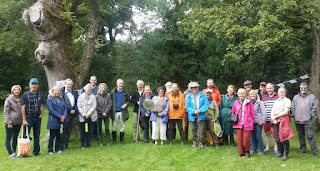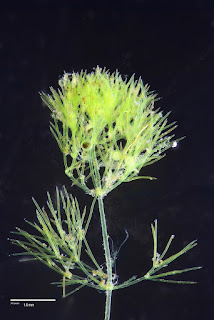 |
| Ellen Hutchins Festival: Meeting point for the lichen foray in Ballylickey Image: C. Heardman |
Clare has been busy organising this weekend's Cork Recording Event but below, she offers an account of another botanical event she has been involved with recently in her day job as NPWS Conservation Ranger.
Over to Clare:
 |
| Fucus capillaris collected by Ellen Hutchins in Bantry Bay, 1808. Reproduced with the kind permission of The Herbarium, Botany Department, Trinity College Dublin. |
"The festival proved so popular that the organisers - me, Madeline Hutchins (Ellen Hutchins’ great great grandniece) and Angela O’Donovan (BantryHistorical Society) - decided to make the event an annual fixture.
"This year the festival started with a seaweed event on
Whiddy Island, which was one of the places Ellen visited in the early 1800s, recording
and collecting seaweeds.
"Her finds included species which were first described from Bantry Bay and have thus been preserved as type specimens.
"The event was led by Dr Susan Steele (Sea Fisheries Protection Authority), who walked us in Ellen’s footsteps, collecting and preserving samples early-1800s style by floating them on to paper.
"Ellen pre-dated photography and posting specimens of fragile algae to botanists in the UK was a fraught task, so she turned her hand to botanical art, producing some exquisite illustrations.
"Most of Ellen’s original artworks are
held in institutions in Britain, but last year permission was obtained from the
museum at Kew Gardens to reproduce some of her seaweed drawings.
"This year the framed prints were displayed in an art trail that stretched from Bantry to Ballylickey and Glengarriff.
"Also displayed in shop windows and other premises,
were exhibition panels and prints of some of her specimens, reproduced with the
kind permission of institutions such as Trinity College Dublin (TCD).
"Her finds included species which were first described from Bantry Bay and have thus been preserved as type specimens.
 |
| Pelvetia canaliculata collected by a participant in the seaweed event 2016 Bantry Bay Image: C. Heardman |
"The event was led by Dr Susan Steele (Sea Fisheries Protection Authority), who walked us in Ellen’s footsteps, collecting and preserving samples early-1800s style by floating them on to paper.
"Ellen pre-dated photography and posting specimens of fragile algae to botanists in the UK was a fraught task, so she turned her hand to botanical art, producing some exquisite illustrations.
 |
| Art workshop in progress, Bantry House Stables Image: C. Heardman |
"This year the framed prints were displayed in an art trail that stretched from Bantry to Ballylickey and Glengarriff.
 |
| Live botanical art demonstration with Shevaun Doherty. Image: C. Heardman |
"Continuing the art theme, award-winning botanical artist
Shevaun Doherty gave a wonderful two-day workshop in the atmospheric location
of Bantry House Stables and Gardens. Like Ellen, Shevaun produces the most
exquisite and accurate watercolours of plants.
"The workshop was followed by a live art demonstration by Shevaun in Organico Café. Meanwhile budding artists aged 4-14, took part in a nature art event which including doing leaf rubbings.
"The workshop was followed by a live art demonstration by Shevaun in Organico Café. Meanwhile budding artists aged 4-14, took part in a nature art event which including doing leaf rubbings.
"Another workshop which took place during the festival was a
two-day introduction to cryptogams, the branch of botany that Ellen specialised
in.
"Dr Howard Fox, a botanist based in the herbarium at the National Botanic
Gardens Glasnevin, and his partner Maria Cullen, took the participants on a
journey into the world of lichens, bryophytes and algae at Ballylickey House, where
Ellen was born, and Ardnagashel Estate, where she spent the last few months of
her life.
 |
| A rubbing of a fern during one of the children’s nature art events Image: C. Heardman |
"At a panel discussion later in the week, Howard, Shevaun and
Madeline were joined on the stage by Sean Moffatt. Sean is a scriptwriter for
television and radio who became fascinated by Ellen’s story and produced a
piece for RTE last year about the discovery of some of Ellen’s specimens in
TCD.
"The contributions of the four panellists were complemented by a pop-up
exhibition of photos, letters, books, prints and other Ellen-related
memorabilia which is owned by the Hutchins family. The pop-up exhibition also
proved a popular attraction at Bantry House during their open garden day as
part of Heritage Week.
 |
| Looking at lichens on the shore at Ardnagashel with Dr Howard Fox Image: C. Heardman |
"The festival was rounded off by a fascinating walk in Glengarriff Woods Nature Reserve led by the passionate and knowledgeable Dr Padraig Whelan of University College Cork. Padraig knows the woods very well, having been bringing students to the Reserve for at least 20 years. He has inspired a generation of students and was equally inspirational to those who attended his walk.
 |
| Group at Glengarriff Woods Nature Reserve with Dr Padraig Whelan Image: C. Heardman |
Many thanks to Clare for this account and fingers crossed that the weather is kind this weekend to her and all the other botanists attending the Cork Recording Event. Watch this space for updates on which plants they find, or follow the action on Twitter!







